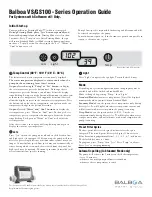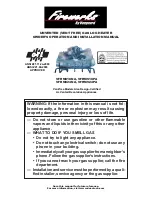
16 www.hotwater
.com 100324051_2000579115
_Rev. 01
INSTALLING THE NEW WATER HEATER
WATER PIPING
To reduce the risk of unusually hot water reaching
the fixtures in the house, install Thermostatic Mixing
Valves (see Figure 6) at each point-of-use.
Water temperature over
125°F can cause severe
burns instantly resulting in
severe injury or death.
Children, the elderly and the
disabled are at highest risk
of scald injury.
Feel water before bathing or
showering.
Temperature limiting devices
such as mixing valves must
be installed when required
by codes and to ensure safe
temperatures at fixtures.
BURN
HOT
HOT
DANGER
The water supply pressure should not exceed 80 psi. If this
occurs, a pressure reducing valve with a bypass should be
installed in the cold water inlet line. This should be placed
on the supply to the entire house in order to maintain equal
hot and cold water pressures.
HOT WATER CAN SCALD:
Water heaters are intended to produce hot water. Water
heated to a temperature which will satisfy space heating,
clothes washing, dish washing, cleaning and other
sanitizing needs can scald and permanently injure you upon
contact. Some people are more likely to be permanently
injured by hot water than others. These include the elderly,
children, the infirm, or physically/mentally handicapped.
If anyone using hot water fits into one of these groups
or if there is a local code or state law requiring certain
temperature water at the hot-water tap, then you must take
special precautions. In addition to using lowest possible
temperature setting that satisfies demand of application,
to reduce the risk of scalding, install Thermostatic Mixing
Valves (temperature limiting valves) (see Figure 6) at each
point-of-use. These valves automatically mix hot and cold
water to limit the temperature at the tap.
SPACE HEATING AND POTABLE WATER SYSTEMS
This appliance has been design certified as complying
with American National Standard/CSA Standard for water
heaters and is suitable for combination water (potable)
heating and space heating but not space heating only
applications.
Toxic Chemical Hazard
WARNING
•
Do not connect to non-potable water system.
Consult a Qualified Installer or Service Agency. Follow
manufacturer’s instructions for installation of valves.
Before changing the factory setting on thermostat, read
"Operating The Temperature Control System" section in
this manual.
•
This water heater should not be connected to any
heating systems or components previously used with
a non-potable water heating appliance.
•
All piping components connected to this unit for space
heating applications should be suitable for use with
potable water.
•
Toxic chemicals, such as those used for boiler treatment
shall not be introduced into the potable water used for
space heating.
•
If the space heating system requires water temperatures
in excess of 120°F, install a Thermostatic Mixing Valve
(see Figure 6) in the domestic (potable) hot water
supply at each point-of-use to limit the risk of scald
injury.
Note:
Water piping and vent piping occupy the space
above the water heater. Plan the water piping to ensure
it does not cause interference with the vent piping (see
“Planning the Vent System”).
If this water heater is to be used to supply both space
heating and potable water, the instructions listed below
must be followed:
•
Be sure to follow the manual(s) shipped with the air
handler or other type heating system.
•
This water heater is not to be used as a replacement
for an existing boiler installation.
•
Do not use with piping that has been treated with
chromates, boiler seal or other chemicals and do not
add any chemicals to the water heater piping.
•
Pumps, valves, piping and fittings must be compatible
with potable water.
•
A properly installed flow control valve is required to
prevent thermosiphoning. Thermosiphoning is the
result of a continuous flow of water through the air
handler circuit during the off cycle. Weeping (blow off)
of the temperature-pressure relief valve (T&P) or higher
than normal water temperatures are the first signs of
thermosiphoning.
•
The hot-water line from the water heater should be
vertical past any mixing valve or supply line to the
heating system to remove air bubbles from the system.
•
Do not connect the water heater to any system or
components previously used with non-potable water
heating appliances when used to supply potable water.
















































